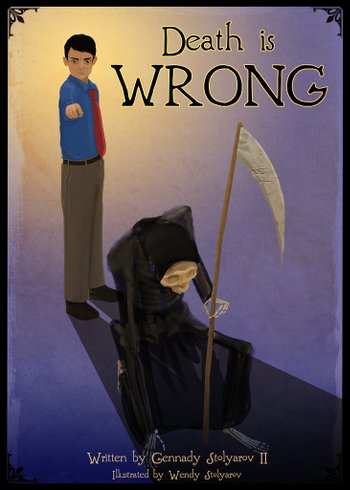Death is Wrong
by Gennady Stolyarov II
illustrated by Wendy Stolyarov
Rational Argumentator Press: 2013, 2014
42 pages
Why not live?
 Death is Wrong, by philosopher and futurist Gennady Stolyarov II, is a small book on a great theme, aimed primarily at younger readers. It's an engagingly personal discussion of why we ought not to take death for granted, so perhaps someday we need not take it for granted.
Death is Wrong, by philosopher and futurist Gennady Stolyarov II, is a small book on a great theme, aimed primarily at younger readers. It's an engagingly personal discussion of why we ought not to take death for granted, so perhaps someday we need not take it for granted.
It's important to note that indefinite life extension is a reasonable goal to consider for mankind; negligible senescence is an alternate phrase Stolyarov uses for it. This does not mean divine elevation to Heaven or Olympus, nor does it require invulnerability to mortal accident. Advances in medicine and the understanding of the human organism have done wonders for human health during the last couple of centuries. I suppose it's likely that extending the human lifespan will occur incrementally resulting from a host of specialized improvements, rather than from a magic-bullet general antitoxin as James Blish discusses in his story "At Death's End" (1954).
The important prerequisite is a change in attitude. Be open to the possibilities. As individuals, and as individuals working through corporations and independent organizations, why not encourage the idea of life extension, and efforts toward that goal? Why not try for it?
Stolyarov begins Death is Wrong with reminiscences from his own childhood dealing with time and years, lifespans and mortality:
One day at age five, in the late spring of 1993, I was visiting the Minsk Botanical Garden with my grandmother. We sat down on a bench overlooking a large pond where ducks and swans swam. On that sunny, temperate day, hundreds of flowers were in bloom, and I was amazed at the abundance and variety of colors in the world. "How," I asked, "could it ever be right for all this experience to just end? How could it be right that, one day, I would never again witness this beauty, or anything else, or even remember having experienced it?" After death, I understood, a person no longer is even aware of having lived. It is as if one never existed. I made a promise to myself then that I would wage war on death, that I would not allow my life and memories to be snuffed out.
Many of us wondered thusly when young or perhaps older, even if not so clearly or as dedicated as young Gennady. Ever since I can remember, I've felt the old children's bedtime prayer as absolutely chilling:
Now I lay me down to sleep,
I pray the Lord my soul to keep,
If I shall die before I wake,
I pray the Lord my soul to take. Amen.
There are other versions of the prayer not suggesting morbidity, but this Colonial-era version from The New-England Primer is the one that everyone still seemed to know when I was a boy. Acceptance despite fear certainly has something important to recommend it. But gentler versions of the prayer aside, is it not past time to question this version's underlying premise that the child may expect death in the normal course of events, even tonight?
The book addresses in clear language many issues related to life extension: health, old age, overpopulation, self-fulfillment, and so on. A lot is presented here, very compactly but easy to understand. Stolyarov's behind-the-scenes essay about the book is interesting in itself, from a variety of angles. A sample:
I ... wanted to make a unique contribution that could turn the tide of cultural attitudes toward life extension and toward death itself. After years of brainstorming and months of concerted activity on the part of both me and my wife and illustrator Wendy Stolyarov, the result is Death is Wrong — an illustrated children's book on life extension that is the first of its kind. ...
Virtually everyone learns about death as a child, and the initial reaction is the correct one: bewilderment, horror, and outrage. Yet there has been no resource to validate these completely correct first impressions. Almost immediately, the young ones are met with excuses and rationalizations, so that they might be consoled and return to a semblance of normalcy. Over millennia of facing indeed inevitable demises, humans have constructed elaborate edifices of rationalization, designed to keep thoughts of death from intruding upon their day-to-day lives. While understandable in eras when technological progress could not have been expected to attain radical life extension (see Benjamin Franklin's famous lament that he was born too soon), today such evasions of the grave wrong of death are among the most counterproductive attitudes imaginable.
Gennady Stolyarov II
"Why I Wrote a Children's Book on Indefinite Life Extension"
As an American Civil War buff myself, I find particularly fascinating in this background essay his analogy with William Lloyd Garrison and the Abolitionist movement.
Death is Wrong is a short book, clearly written and easy to read. I like the personal approach: it doesn't talk down and is quite accessible. A striking concept presented quite reasonably and supported matter-of-factly. There are apt quotations from a variety of thinkers, including several of my personal heroes of modern times: Francis Bacon, Benjamin Franklin, Friedrich Nietzsche. These people and some scenes from nature are nicely illustrated by Wendy Stolyarov. For readers who want a little more about the background concepts, there is a brief Appendix discussing the seven basic causes of senescence, such as cell loss and atrophy. There are some links for further learning.
It's a good book, entertaining and thoughtful, and certainly gives us a challenge to think about.
The world is deep,
Deeper than day had been aware.
Deep is its woe;
Joy — deeper yet than agony:
Woe implores: Go!
But all joy wants eternity —Friedrich Nietzsche
"The Drunken Song"
Thus Spoke Zarathustra, IV.19.10 (1885)
translated by Walter Kaufmann
in The Portable Nietzsche
© 2015 Robert Wilfred Franson
Gennady Stolyarov II's site
The Rational Argumentator
A Journal for Western Man —
Championing Reason, Rights, and Progress Since 2002
Wendy Stolyarov's site
Wendy Stolyarov, Illustrator & Graphic Designer
Breathers at Troynovant
lifeforms & biologic processes:
wildlife & pets, evolution & ecology,
health, medicine, & disease
Juvenile at Troynovant
for a younger audience
| Troynovant, or Renewing Troy: | New | Contents | |||
| recurrent inspiration | Recent Updates | |||
|
www.Troynovant.com |
||||
|
Reviews |
||||
| Personae | Strata | Topography |
|
|||
